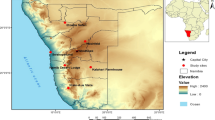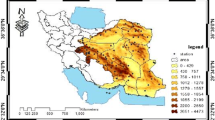Abstract
Tourism plays an essential role in the economic development of a country and has become a growing phenomenon of global importance. The climate change on the other hand has a direct effect and degrades the environmental components and features of the destinations. Pakistan is highly vulnerable to changing the climate which has threatened the tourism sector. The study has emphasized on the significance of the climate in the tourism industry by using the Tourism Climate Index (TCI) which highlights suitable regions and seasons. TCI has been used worldwide to enumerate the impacts of climate change on tourism and tourist destinations. The current study calculates the TCI for four cities of Pakistan, chosen by public opinion. For measuring the index, climatic data of twenty-one years (1997–2017) were taken from the Pakistan Meteorological Department, which include temperature, precipitation, sunshine hours, humidity and wind speed. The results showed that among the seasonal distribution, autumn and spring are good seasons for tourism. Climatic suitability in summer was not favorable for Lahore and Islamabad because of high rainfall and lower thermal comfort. A rapid change in the Annual TCI score was observed and investigated through the contribution of TCI components which happens to be the core reason for the change. Analysis has shown that 75% of the study area as a Bi-modal shoulder peak and 25% as a winter peak. For city Lahore, a maximum number of months were observed as “Excellent” and “Good” for tourism due to a high TCI score. Furthermore, future projection predicts that tourism in Lahore will be highly threatened due to rapidly changing climate. Government and tourism stakeholders should conduct such relevant studies at large scale for a better understanding of favorable and unsuitable tourist destinations across Pakistan.











Similar content being viewed by others
References
Akram, N., & Hamid, A. (2015). Climate change: A threat to the economic growth of Pakistan. Progress in Development Studies, 15(1), 73–86.
Alasttal, M. N. M., & Burdey, M. B. (2017). An Exploratory Analysis Of Pakistan Tourism Market: Its Present Scenario, Issues, Challenges And Future Prospects. Grassroots, 50(3).
Ali, S. A., Haider, J., Ali, M., Ali, S. I., & Ming, X. (2017). Emerging tourism between Pakistan and China: tourism opportunities via China-Pakistan economic corridor. International Business Research, 10(8), 204.
Amelung, B., & Nicholls, S. (2014). Implications of climate change for tourism in Australia. Tourism Management, 41, 228–244.
Amiranashvili, A. G., Chargazia, K. Z., & Matzarakis, A. (2014). Comparative characteristics of the tourism climate index in the south Caucasus Countries Capitals (Baku, Tbilisi, Yerevan). Journal of the Georgian Geophysical Society, 17(C).
Arshad, M. I., Iqbal, M. A., & Shahbaz, M. (2018). Pakistan tourism industry and challenges: a review. Asia Pacific Journal of Tourism Research, 23(2), 121–132.
Becken, S., Zammit, C., & Hendrikx, J. (2015). Developing climate change maps for tourism: essential information or awareness raising? Journal of Travel Research, 54(4), 430–441.
Chaudhary, Qamar Uz Zaman. (2017). Climate Change Profile Of Pakistan. Asian Development Bank. DOI: http://dx.doi.org/https://doi.org/10.22617/TCS178761
Day, J., Chin, N., Sydnor, S., & Cherkauer, K. (2013). Weather, climate, and tourism performance: A quantitative analysis. Tourism Management Perspectives, 5, 51–56.
Fang, Y., & Yin, J. (2015). National assessment of climate resources for tourism seasonality in China using the tourism climate index. Atmosphere, 6(2), 183–194.
Farajzadeh, H., & Matzarakis, A. (2009). Quantification of climate for tourism in the northwest of Iran. Meteorological Applications, 16(4), 545–555.
Fitchett, J. M., Grant, B., & Hoogendoorn, G. (2016). Climate change threats to two low-lying South African coastal towns: Risks and perceptions. South African Journal of Science, 112(5–6), 1–9.
Fitchett, J. M., Robinson, D., & Hoogendoorn, G. (2017). Climate suitability for tourism in South Africa. Journal of Sustainable Tourism, 25(6), 851–867.
Hamilton, J. M., Maddison, D. J., & Tol, R. S. (2005). Effects of climate change on international tourism. Climate Research, 29(3), 245–254.
IPCC. (2014) Climate change 2014: Synthesis report. In Core writing team, R. K. Pachauri, & L. A. Meyer (Eds.). Contribution of working groups I, II and III to the fifth assessment report of the intergovernmental panel on climate change (p. 151). Geneva: IPCC.
Jawtusch, J. (2014). Climate change and disaster risk guide: Which climate and disaster risks affect South African and how do they affect South Africa.
Jeuring, J., & Becken, S. (2013). Tourists and severe weather–An exploration of the role of ‘Locus of Responsibility’in protective behaviour decisions. Tourism Management, 37, 193–202.
Kovacs, A., Unger, J., Gál, C. V., & Kántor, N. (2016). Adjustment of the thermal component of two tourism climatological assessment tools using thermal perception and preference surveys from Hungary. Theoretical and Applied Climatology, 125(1–2), 113–130.
Kubokawa, H., Inoue, T., & Satoh, M. (2014). Evaluation of the Tourism Climate Index over Japan in a future climate using a statistical downscaling method. Journal of the Meteorological Society of Japan. Ser. II, 92(1), 37–54.
Liu, T. M. (2016). The influence of climate change on tourism demand in Taiwan national parks. Tourism Management Perspectives, 20, 269–275.
Manly, B. F. (2008). Statistics for Environmental Science And Management (2nd ed.). Chapman & Hall/CRC: Florida.
Matzarakis, A., & Rutz, F. (2005). Application of RayMan for tourism and climate investigations. Annalen der Meteorologie, 41(2), 631–636.
Michailidou, A. V., Vlachokostas, C., & Moussiopoulos, Ν. (2016). Interactions between climate change and the tourism sector: Multiple-criteria decision analysis to assess mitigation and adaptation options in tourism areas. Tourism Management, 55, 1–12.
Mieczkowski, Z. (1985). The tourism climatic index: a method of evaluating world climates for tourism. Canadian Geographer/Le Géographe Canadien, 29(3), 220–233.
Morgan, R., Gatell, E., Junyent, R., Micallef, A., Özhan, E., & Williams, A. T. (2000). An improved user-based beach climate index. Journal of Coastal Conservation, 6(1), 41–50.
Olya, H. G., & Alipour, H. (2015). Risk assessment of precipitation and the tourism climate index. Tourism Management, 50, 73–80.
Perch-Nielsen, S., Sesartic, A., & Stucki, M. (2010). The greenhouse gas intensity of the tourism sector: The case of Switzerland. Environmental Science & Policy, 13(2), 131–140.
Peric, J., Jurdana, D. S., & Grdic, Z. S. (2013). Croatian tourism sector’s adjustment to climate change. Tourism Management Perspectives, 6, 23–27.
Pongkijvorasin, S., & Chotiyaputta, V. (2013). Climate change and tourism: Impacts and responses. A case study of Khaoyai National Park. Tourism Management Perspectives, 5, 10–17.
Ramazanipour, M., & Behzadmoghaddam, E. (2013). Analysis of tourism climate index of Chaloos City. Int J of Humanities and Management Sciences, 1, 290–292.
Rashid, T., & Robinson, N. (2010). Crisis and risks in tourism: Death takes a holiday–debunking the myth of terrorism and its psychological impact on the tourism industry. International Journal of Tourism Policy, 3(4), 348–353.
Richardson, R. B., & Loomis, J. B. (2004). Adaptive recreation planning and climate change: a contingent visitation approach. Ecological Economics, 50(1–2), 83–99.
Ridderstaat, J., Oduber, M., Croes, R., Nijkamp, P., & Martens, P. (2014). Impacts of seasonal patterns of climate on recurrent fluctuations in tourism demand: Evidence from Aruba. Tourism Management, 41, 245–256.
Roshan, G., Yousefi, R., & Fitchett, J. M. (2016). Long-term trends in tourism climate index scores for 40 stations across Iran: the role of climate change and influence on tourism sustainability. International Journal of Biometeorology, 60(1), 33–52.
Scott, D., & Lemieux, C. (2010). Weather and climate information for tourism. Procedia Environmental Sciences, 1, 146–183.
Shahzad, L., Tahir, A., Sharif, F., Khan, W. U., Farooq, M. A., Abbas, A., & Saqib, Z. A. (2019). Vulnerability, wellbeing and livelihood adaptation under changing environmental conditions: a case from mountainous region of Pakistan. Environmental Science and Pollution Research, 26(26), 26748–26764. https://doi.org/10.1007/s11356-019-05880-x.
Shakoor, A. (2011). Investigating biophysics and bioclimate effect on the health of tourists in Yazd Province using tourism climate index (TCI). International Journal of Physical Sciences, 6(28), 6607–6622.
Tang, M. (2013). Comparing the ‘tourism climate index’and ‘holiday climate index’ in major European urban destinations (Master's thesis, University of Waterloo).
Ullah, W., & Takaaki, N. (2016). Climate Change Vulnerability of Pakistan Towards Natural Disasters: A Review. International Journal of Environmental Protection and Policy, 4(5), 1–7.
Underhill, L., & Bradfield, D. (2013). INTROSTAT (Statistics textbook). (Textbook). University of Cape Town ,Faculty of Science ,Department of Statistical Sciences. Retrieved from http://hdl.handle.net/11427/4150
United Nations World Tourism Organization (2008). Climate Change and Tourism – Responding to Global Challenges. June 200. https://www.eunwto.org/doi/book/10.18111/9789284412341.
United Nations World Tourism Organization (2020). UNWTO World Tourism Barometer Nº18. January 2020, Vol. 18, Issue 1, pp. 1–4. https://www.unwto.org/world-tourism-barometer-n18-january-2020.
World Travel & Tourism Council (2018). Travel & Tourism Economic Impact Pakistan: 2018 Edition, WTTC,
World Travel & Tourism Council (2019). Travel & Tourism Economic Impact World: 2019 Edition, WTTC, https://www.slovenia.info/uploads/dokumenti/raziskave/raziskave/world2019.pdf
Ziervogel, G., New, M., Archer van Garderen, E., Midgley, G., Taylor, A., Hamann, R., & Warburton, M. (2014). Climate change impacts and adaptation in South Africa. Wiley Interdisciplinary Reviews: Climate Change, 5(5), 605–620.
Author information
Authors and Affiliations
Corresponding author
Additional information
Publisher's Note
Springer Nature remains neutral with regard to jurisdictional claims in published maps and institutional affiliations.
Rights and permissions
About this article
Cite this article
Shahzad, L., Tahir, A., Dogar, M. et al. A metric-based assessment of climate and tourism in major cities of Pakistan. Environ Dev Sustain 23, 13607–13627 (2021). https://doi.org/10.1007/s10668-021-01230-5
Received:
Accepted:
Published:
Issue Date:
DOI: https://doi.org/10.1007/s10668-021-01230-5




